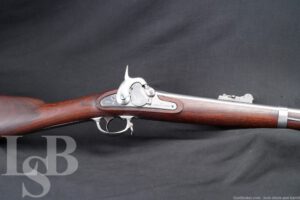
US Springfield Model 1855 Rifle Maynard Primer Percussion 1858 Reproduction
SOLD FOR: $2626.01
LSB#: 230329KK035
Make: Harper’s Ferry
Model: Springfield M1855
Serial Number: NSNV
Year of Manufacture: 1858, Reproduction.
Caliber: .58, Barrel is a Whitacre replacement.
Action Type: Percussion Rifled-Musket with Maynard Tape Primer System
Barrel Length: 40”
Sights / Optics: The front sight is a blade integral to a rectangular base. The front sight also serves as the bayonet lug (no bayonet included). The rear sight is a “V”-notched sliding escalator that flips up to become a ladder sight.
Stock Configuration & Condition: The stock is a one piece hardwood with straight grip, brass nose cap, channel with ram rod included, three barrel bands, two sling loops, a patchbox, and a metal butt plate. The wood shows light scratches, scrapes, and dings from handling and storage marks. The barrel bands show discoloration from oxidation. The butt plate shows surface erosion and scratches. The LOP measures 13.5” from the front of the trigger to the back of the butt plate. The stock rate in about Very Good overall condition, for its age.
Type of Finish: In the White
Finish Originality: Rebuilt
Bore Condition: The muzzle and grooves are bright, rifling is sharp. There is a patch of erosion at the muzzle. In this writer’s opinion and for the age, this bore rates a 9 out of 10.
Most antique firearms have bores that will show erosion. This is not only due to age but to the use of black powder. When fired, black powder reacts corrosively. NRA Antique Firearm Conditions Standards are quite lenient for bores. In some cases the NRA standards disregarded the bore’s condition for collectors firearms.
Overall Condition: This rifle retains about 97% of its metal finish as rebuilt. The metal shows light scratches from handling and storage. The barrel is a replacement and does show scattered light oxidation. The hammer, lock and bottom metal show small flecks of surface oxidation. The screw heads are sharp. The markings are deep. Overall, this rifle rates in about Very Good Plus condition as rebuilt.
Mechanics: The action functions correctly. The Maynard Primer Tape mechanism is functioning. We did not fire this firearm. As with all used firearms, a thorough cleaning may be necessary to meet your maintenance requirements.
Box, Paperwork & Accessories: None.
Our Assessment: The barrel on the Model 1855 was .58 caliber, which was smaller than previous muskets. The Springfield Model 1816 and all of its derivatives up through the Springfield Model 1842 had been .69 caliber, but tests conducted by the U.S. Army showed that the smaller .58 caliber was more accurate when used with a Minié ball. The Model 1855 also used the Maynard tape primer, which was an attempt at improving the percussion cap system that had been previously developed. Instead of using individual caps which had to be placed for every shot, the Maynard system used a tape which was automatically fed every time the hammer was cocked, similar to the way a modern child’s cap gun works. While the powder and Minié ball still had to be loaded conventionally, the tape system was designed to automate the placing of the percussion cap and therefore speed up the overall rate of fire of the weapon. The Maynard tape system gave the Model 1855 a unique hump under the rifled musket’s hammer. The weapon could also be primed in the usual way with standard percussion caps if the tape was unavailable. The Secretary of War at the time Jefferson Davis authorized the adoption of the Maynard system for the Model 1855. In the field, the Maynard tape primer proved to be unreliable. Tests conducted between 1859 and 1860 found that half of the primers misfired, and also reported that the tape primer springs did not feed well. The greatest problem was the actual tape itself. Despite being advertised as waterproof, the paper strips proved to be susceptible to moisture. An attempt was made to remedy this problem by making the tape primers out of foil, but despite the improvement this brought, the United States Army Ordnance Department abandoned the Maynard system and went back to the standard percussion lock in later rifled muskets like the Model 1861.
This reproduction Springfield Model 1855 has been rebarreled by Whitacre’s Machine Shop who specializes in muzzleloading military rifles and has had the sights reattached by Whitacre. The markings are John Zimmerman and the rifle has been gone through by his shop. It also features all of the markings an original would. This would be an excellent rifle to target shoot Confederate or Union troops with.
-Luke

